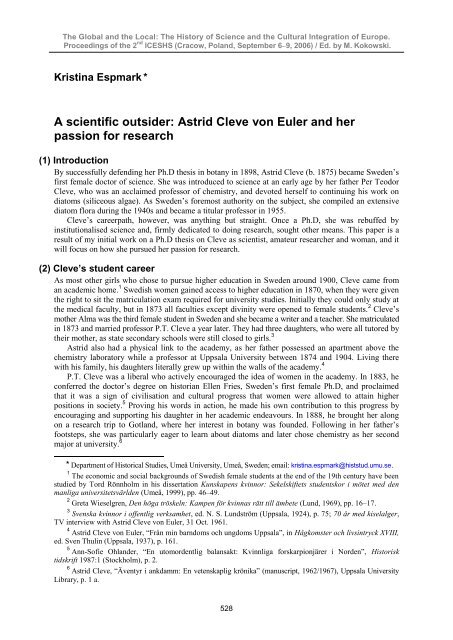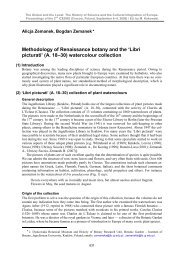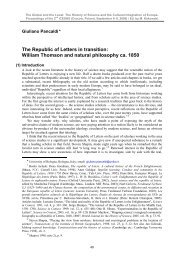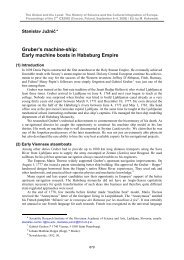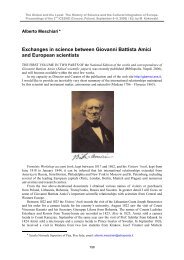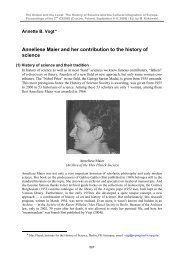A scientific outsider: Astrid Cleve von Euler and her ... - 2nd ICESHS
A scientific outsider: Astrid Cleve von Euler and her ... - 2nd ICESHS
A scientific outsider: Astrid Cleve von Euler and her ... - 2nd ICESHS
Create successful ePaper yourself
Turn your PDF publications into a flip-book with our unique Google optimized e-Paper software.
The Global <strong>and</strong> the Local: The History of Science <strong>and</strong> the Cultural Integration of Europe.<br />
Proceedings of the 2 nd <strong>ICESHS</strong> (Cracow, Pol<strong>and</strong>, September 6–9, 2006) / Ed. by M. Kokowski.<br />
Kristina Espmark *<br />
A <strong>scientific</strong> <strong>outsider</strong>: <strong>Astrid</strong> <strong>Cleve</strong> <strong>von</strong> <strong>Euler</strong> <strong>and</strong> <strong>her</strong><br />
passion for research<br />
(1) Introduction<br />
By successfully defending <strong>her</strong> Ph.D thesis in botany in 1898, <strong>Astrid</strong> <strong>Cleve</strong> (b. 1875) became Sweden’s<br />
first female doctor of science. She was introduced to science at an early age by <strong>her</strong> fat<strong>her</strong> Per Teodor<br />
<strong>Cleve</strong>, who was an acclaimed professor of chemistry, <strong>and</strong> devoted <strong>her</strong>self to continuing his work on<br />
diatoms (siliceous algae). As Sweden’s foremost authority on the subject, she compiled an extensive<br />
diatom flora during the 1940s <strong>and</strong> became a titular professor in 1955.<br />
<strong>Cleve</strong>’s careerpath, however, was anything but straight. Once a Ph.D, she was rebuffed by<br />
institutionalised science <strong>and</strong>, firmly dedicated to doing research, sought ot<strong>her</strong> means. This paper is a<br />
result of my initial work on a Ph.D thesis on <strong>Cleve</strong> as scientist, amateur researc<strong>her</strong> <strong>and</strong> woman, <strong>and</strong> it<br />
will focus on how she pursued <strong>her</strong> passion for research.<br />
(2) <strong>Cleve</strong>’s student career<br />
As most ot<strong>her</strong> girls who chose to pursue hig<strong>her</strong> education in Sweden around 1900, <strong>Cleve</strong> came from<br />
an academic home. 1 Swedish women gained access to hig<strong>her</strong> education in 1870, when they were given<br />
the right to sit the matriculation exam required for university studies. Initially they could only study at<br />
the medical faculty, but in 1873 all faculties except divinity were opened to female students. 2 <strong>Cleve</strong>’s<br />
mot<strong>her</strong> Alma was the third female student in Sweden <strong>and</strong> she became a writer <strong>and</strong> a teac<strong>her</strong>. She matriculated<br />
in 1873 <strong>and</strong> married professor P.T. <strong>Cleve</strong> a year later. They had three daughters, who were all tutored by<br />
their mot<strong>her</strong>, as state secondary schools were still closed to girls. 3<br />
<strong>Astrid</strong> also had a physical link to the academy, as <strong>her</strong> fat<strong>her</strong> possessed an apartment above the<br />
chemistry laboratory while a professor at Uppsala University between 1874 <strong>and</strong> 1904. Living t<strong>her</strong>e<br />
with his family, his daughters literally grew up within the walls of the academy. 4<br />
P.T. <strong>Cleve</strong> was a liberal who actively encouraged the idea of women in the academy. In 1883, he<br />
conferred the doctor’s degree on historian Ellen Fries, Sweden’s first female Ph.D, <strong>and</strong> proclaimed<br />
that it was a sign of civilisation <strong>and</strong> cultural progress that women were allowed to attain hig<strong>her</strong><br />
positions in society. 5 Proving his words in action, he made his own contribution to this progress by<br />
encouraging <strong>and</strong> supporting his daughter in <strong>her</strong> academic endeavours. In 1888, he brought <strong>her</strong> along<br />
on a research trip to Gotl<strong>and</strong>, w<strong>her</strong>e <strong>her</strong> interest in botany was founded. Following in <strong>her</strong> fat<strong>her</strong>’s<br />
footsteps, she was particularly eager to learn about diatoms <strong>and</strong> later chose chemistry as <strong>her</strong> second<br />
major at university. 6<br />
* Department of Historical Studies, Umeå University, Umeå, Sweden; email: kristina.espmark@histstud.umu.se .<br />
1 The economic <strong>and</strong> social backgrounds of Swedish female students at the end of the 19th century have been<br />
studied by Tord Rönnholm in his dissertation Kunskapens kvinnor: Sekelskiftets studentskor i mötet med den<br />
manliga universitetsvärlden (Umeå, 1999), pp. 46–49.<br />
2 Greta Wieselgren, Den höga tröskeln: Kampen för kvinnas rätt till ämbete (Lund, 1969), pp. 16–17.<br />
3 Svenska kvinnor i offentlig verksamhet, ed. N. S. Lundström (Uppsala, 1924), p. 75; 70 år med kiselalger,<br />
TV interview with <strong>Astrid</strong> <strong>Cleve</strong> <strong>von</strong> <strong>Euler</strong>, 31 Oct. 1961.<br />
4 <strong>Astrid</strong> <strong>Cleve</strong> <strong>von</strong> <strong>Euler</strong>, “Från min barndoms och ungdoms Uppsala”, in Hågkomster och livsintryck XVIII,<br />
ed. Sven Thulin (Uppsala, 1937), p. 161.<br />
5 Ann-Sofie Ohl<strong>and</strong>er, “En utomordentlig balansakt: Kvinnliga forskarpionjärer i Norden”, Historisk<br />
tidskrift 1987:1 (Stockholm), p. 2.<br />
6 <strong>Astrid</strong> <strong>Cleve</strong>, “Äventyr i ankdamm: En vetenskaplig krönika” (manuscript, 1962/1967), Uppsala University<br />
Library, p. 1 a.<br />
528
CHAPTER 18. / Symposium R-10.<br />
From Maria Sklodowska-Curie to the 21st century ...<br />
After the trip to Gotl<strong>and</strong>, <strong>Cleve</strong> spent ten years studying hard. She matriculated unusually young,<br />
only sixteen years old, <strong>and</strong> immediately continued <strong>her</strong> studies at Uppsala University. Her bachelor’s<br />
degree was completed in 1894 <strong>and</strong> she commenced <strong>her</strong> career as a diatom expert a year later with the<br />
treatise On Recent Freshwater Diatoms from Lule Lappmark in Sweden, published by the Royal<br />
Swedish Academy of Sciences. In May 1898, she became Sweden’s first female doctor of science,<br />
with a dissertation on the influence of living conditions on the growth of certain plants, entitled<br />
Studier öfver några svenska växters groningstid och förstärkningsstadium. 7<br />
<strong>Cleve</strong> chose to study science for <strong>her</strong> own amusement, describing <strong>her</strong>self as having a “<strong>scientific</strong><br />
disposition”. In order to pursue <strong>her</strong> interest, she desired to debark on a <strong>scientific</strong> career within the<br />
academy. 8 Her dedication to science was also expressed in <strong>her</strong> spare time, which was mainly spent<br />
outdoors. Hiking, canoeing <strong>and</strong> biking through the Swedish countryside throughout <strong>her</strong> life, she<br />
gat<strong>her</strong>ed specimens <strong>and</strong> samples to examine <strong>and</strong> systematize. Her own dissertation was based on seeds<br />
gat<strong>her</strong>ed on a three-week trek through Lapl<strong>and</strong>, <strong>and</strong> even recreational travels abroad resulted in<br />
botanical notes.<br />
(3) Making a living<br />
<strong>Astrid</strong> <strong>Cleve</strong>’s dream of an academic career was more or less shattered when she received <strong>her</strong><br />
dissertation grade, which was not good enough to earn <strong>her</strong> the academic title “docent”. Without it, she<br />
would not be considered for employment as a lecturer at any university, a great disappointment to <strong>her</strong><br />
<strong>and</strong>, though t<strong>her</strong>e is no known evidence for it, she believed that <strong>her</strong> grade had been consciously<br />
depreciated due to <strong>her</strong> gender. 9 The year before, jurist Elsa Eschelsson had become the first Swedish<br />
woman to be awarded the title docent. After <strong>her</strong>, a full twelve female doctors passed before physicist<br />
Eva <strong>von</strong> Bahr became the second female docent in 1908. 10<br />
Lacking the coveted title, however, did not mean t<strong>her</strong>e were no options. Man or woman, docent or<br />
not, t<strong>her</strong>e were more Ph.Ds than t<strong>her</strong>e were available positions at the universities, <strong>and</strong> many had to<br />
find work elsew<strong>her</strong>e. Most became teac<strong>her</strong>s at secondary schools, while ot<strong>her</strong>s found employment at<br />
museums, institutes, libraries or in industry. 11<br />
<strong>Cleve</strong> soon found a job as a chemistry assistant at the private Stockholm College, a position she<br />
enjoyed. Unfortunately, it did not pay sufficiently to guarantee financial security, <strong>and</strong> though she also<br />
taught chemistry at a secondary school for girls, she soon had to find different means of supporting<br />
<strong>her</strong>self. 12 In 1902 she married a colleague, German physicist Hans <strong>von</strong> <strong>Euler</strong>-Chelpin. That solved<br />
<strong>Cleve</strong>’s financial problems, <strong>and</strong> even better, she could still do research as <strong>her</strong> husb<strong>and</strong>’s unpaid<br />
assistant. 13 Since <strong>von</strong> <strong>Euler</strong> conducted research on organic <strong>and</strong> physical chemistry, <strong>Cleve</strong> had both the<br />
interest <strong>and</strong> skill required <strong>and</strong> the collaboration was initially successful. The couple had co-published<br />
several works by the time <strong>von</strong> <strong>Euler</strong> was appointed professor of chemistry in 1906, but then a few<br />
years of <strong>scientific</strong> silence from <strong>Cleve</strong> followed. 14<br />
7 Maj-Britt Florin, “<strong>Astrid</strong> <strong>Cleve</strong> <strong>von</strong> <strong>Euler</strong>”, Svensk Botanisk Tidskrift 62 (Uppsala, 1968), p. 549. In the<br />
years 1891–95, 692 individuals matriculated in Sweden on average per year. 27 of that number were women <strong>and</strong><br />
the students’ mean age was 19.26 years. Sveriges l<strong>and</strong> och folk, ed. Gustav Sundbärg (Stockholm, 1901), pp.<br />
298–299, 306.<br />
8 70 år med kiselalger.<br />
9 Hanna Markusson Winkvist, Som isolerade öar: De lagerkransade kvinnorna och akademin under 1900 -<br />
talets första hälft (Stockholm /Stehag, 2003), p. 108; Heng, “Kvinnlig jubeldoktor bonde många år: Skapar stor<br />
flora över kiselalgerna”, Stockholms-tidningen, 31 Mar. 1948.<br />
10 Markusson Winkvist, Som isolerade öar, p. 232.<br />
11 Markusson Winkvist, Som isolerade öar, p. 108; Thomas Kaiserfeld, Vetenskap och karriär: Svenska<br />
fysiker som lektorer, akademiker och industriforskare under 1900-talets första hälft (Lund, 1997), p. 178.<br />
12 70 år med kiselalger; Lydia Wahlström, Trotsig och försagd (Stockholm, 1949), p. 168.<br />
13 70 år med kiselalger.<br />
14 Florin, “<strong>Astrid</strong> <strong>Cleve</strong> <strong>von</strong> <strong>Euler</strong>”, p. 557.<br />
529
Kristina Espmark<br />
A <strong>scientific</strong> <strong>outsider</strong>: <strong>Astrid</strong> <strong>Cleve</strong> <strong>von</strong> <strong>Euler</strong> <strong>and</strong> <strong>her</strong> passion for research<br />
Though she wanted to conduct research <strong>and</strong> secure a place in science for <strong>her</strong>self <strong>and</strong> <strong>her</strong> husb<strong>and</strong>,<br />
it is likely that <strong>Cleve</strong>’s family situation forced a change of priorities in those years. 15 In 1905, she<br />
experienced a great loss as <strong>her</strong> fat<strong>her</strong>, whom she considered <strong>her</strong> only true supporter in life, unexpectedly<br />
died. 16 Meanwhile, <strong>her</strong> own family grew with five children, born between 1903 <strong>and</strong> 1910. After the<br />
last child, however, the marriage ended in a bitter divorce, finalized in 1912. 17<br />
While <strong>von</strong> <strong>Euler</strong> went on to become a Nobel Prize winner in chemistry in 1929, the divorce left<br />
<strong>Cleve</strong> in a new financially precarious position, this time with five children to care for. She could not<br />
return to <strong>her</strong> previous position at Stockholm College, so she did what many of <strong>her</strong> fellow Ph.Ds of the<br />
time did; she became a teac<strong>her</strong>. Prioritizing supporting <strong>her</strong> family did not mean that she ab<strong>and</strong>oned<br />
research, however. During <strong>her</strong> marriage she continued <strong>her</strong> studies, published a series of articles on<br />
diatoms, wrote ot<strong>her</strong> botanical articles <strong>and</strong> conducted diatom analyses for Quaternary geologists. Furt<strong>her</strong>more,<br />
she worked as an assistant of biology at the Swedish Hydrographical-Biological Commission. 18<br />
In the summer of 1917, the forestry industry offered <strong>Cleve</strong> what the academy would not, as she<br />
was appointed director of a newly-established research laboratory in Skoghall, 300 km west of Uppsala. 19<br />
Industrial laboratories were unusual at the time, but competition, debate on the wastefulness of the forestry<br />
industry <strong>and</strong> possibly profitable by-products motivated new investments. Skoghall’s research facility<br />
was built to analyse tests necessary for the general running of the works, but also to explore new uses<br />
for the vast amount of waste <strong>and</strong> find replacement products for certain materials. 20<br />
<strong>Cleve</strong> embraced <strong>her</strong> new tasks energetically, initiated thorough investigations on wood <strong>and</strong> cellulose<br />
chemistry <strong>and</strong> published several articles on <strong>her</strong> findings. Though <strong>scientific</strong>ally valuable, <strong>her</strong> work<br />
produced few useful alternatives for the company to make profit from, <strong>and</strong> after five years she was<br />
fired. Her scientist’s view of conducting research primarily for the sake of knowledge was deemed<br />
incompatible with the industrial imperative of economic gain. 21<br />
No longer a research laboratory director, <strong>Cleve</strong> moved back to Uppsala <strong>and</strong> applied for a professorship<br />
in agricultural chemistry, hoping <strong>her</strong> extensive qualifications would l<strong>and</strong> <strong>her</strong> the position. Again, she<br />
was rebuffed, <strong>and</strong> again, she blamed <strong>her</strong> gender. A friend of <strong>her</strong>s, a male professor in palaeontology,<br />
had a different explanation <strong>and</strong> said that she would never be hired because it was common knowledge<br />
she would keep researching anyway. 22<br />
(4) A Quaternary geology controversy<br />
Judging from <strong>her</strong> list of publications, he was right, at least about the latter. <strong>Cleve</strong> continuously published<br />
texts, whet<strong>her</strong> she was paid to perform or not. Her publication history during <strong>her</strong> marriage is one example,<br />
a book on wood published six years after leaving the research laboratory a second, <strong>and</strong> publications on<br />
popular science a third. 23 Anot<strong>her</strong> example was <strong>her</strong> commitment to Quaternary geology, which resulted<br />
in many thorough texts, though in this case, <strong>Cleve</strong>’s overstepping of boundaries led to protests from<br />
leading geologists.<br />
<strong>Cleve</strong> had no formal training as a geologist, but she had conducted diatom analyses for Swedish<br />
<strong>and</strong> Finnish Quaternary geologists since before <strong>her</strong> marriage. The Quaternary period is the youngest of<br />
the Earth’s geologic time periods <strong>and</strong> is presently considered to extend from 1.6–2.3 million years ago<br />
to the present. For the geologists, fossils from the salt- <strong>and</strong> fresh-water sensitive diatoms gave important<br />
information on shoreline movements <strong>and</strong> changes in l<strong>and</strong> elevation essential to their research. With<br />
15<br />
<strong>Astrid</strong> <strong>Cleve</strong> <strong>von</strong> <strong>Euler</strong> to Gustaf Retzius, 23 Mar. 1914, Centre for History of Science at the Royal<br />
Swedish Academy of Sciences, Stockholm.<br />
16<br />
70 år med kiselalger; Hans <strong>von</strong> <strong>Euler</strong>-Chelpin, “Per Teodor <strong>Cleve</strong>”, Kungliga svenska vetenskapsakademiens<br />
årsbok 1906, p. 209.<br />
17<br />
70 år med kiselalger; <strong>Cleve</strong> <strong>von</strong> <strong>Euler</strong> to Retzius, 23 Mar. 1914.<br />
18<br />
Svenskt biografiskt lexikon 8 (Stockholm, 1929), p. 649; Florin, “<strong>Astrid</strong> <strong>Cleve</strong> <strong>von</strong> <strong>Euler</strong>”, pp. 557–558.<br />
19 Svenskt biografiskt lexikon 8, p. 649.<br />
20 Bo Sundin, Ingenjörsvetenskapens tidevarv (Stockholm, 1981), pp. 136–137, 150–151.<br />
21<br />
Sundin, Ingenjörsvetenskapens tidevarv, p. 151.<br />
22<br />
70 år med kiselalger.<br />
23<br />
See <strong>Cleve</strong>’s bibliography in Florin, “<strong>Astrid</strong> <strong>Cleve</strong> <strong>von</strong> <strong>Euler</strong>”, pp. 556–564.<br />
530
CHAPTER 18. / Symposium R-10.<br />
From Maria Sklodowska-Curie to the 21st century ...<br />
time, <strong>Cleve</strong> concluded that <strong>her</strong> results were being misused <strong>and</strong> entered the geological debate with <strong>her</strong><br />
own theories.<br />
In 1923, <strong>Cleve</strong> published a paper based on <strong>her</strong> diatom studies <strong>and</strong> reports on various geologists’<br />
findings, in which she suggested that the Sc<strong>and</strong>inavian l<strong>and</strong> mass had oscillated several times during<br />
the melting of the latest l<strong>and</strong> ice. According to <strong>her</strong>, the movement was activated by the diminishing weight<br />
of the ice <strong>and</strong> subsided with each oscillation, similar to a pendulum losing momentum. 24<br />
The response to <strong>her</strong> paper was immediate <strong>and</strong> she was met with more or less <strong>scientific</strong>ally motivated<br />
scepticism. An expert on diatoms stood against trained geologists, both sides defending their field, <strong>and</strong><br />
neit<strong>her</strong> accepting the ot<strong>her</strong> as fully <strong>and</strong> respectably <strong>scientific</strong>. <strong>Cleve</strong> was considered lacking in geological<br />
knowledge <strong>and</strong> accused of using ot<strong>her</strong> people’s findings arbitrarily to reach <strong>her</strong> conclusions, while she<br />
expressed disappointment with the geologists’ lack of free thinking to uncover new facts. She also<br />
failed to follow the hierarchic order within the geological community, refused to accept criticism, <strong>and</strong><br />
presented a retooling of a theory that had already been suggested by geologists <strong>and</strong> dismissed. 25 <strong>Cleve</strong><br />
stood firmly by <strong>her</strong> idea, though, <strong>and</strong> after a year of discussion within the Geological Society of Stockholm,<br />
she was shut out <strong>and</strong> the Society ceased publishing <strong>her</strong> texts. 26<br />
Lack of acceptance did not stop <strong>Astrid</strong> <strong>Cleve</strong>, <strong>and</strong> she continued <strong>her</strong> geological studies. In 1927,<br />
<strong>her</strong> response to a suggestion to make a national monument of an area featuring l<strong>and</strong> ice remnants was<br />
published in one of Sweden’s largest daily papers. Lennart <strong>von</strong> Post <strong>and</strong> Henrik Munthe, both highly<br />
influential geologists, had studied the site, <strong>and</strong> their opinion that the environment was caused by the<br />
outflow of the Ancylus lake, a great Baltic freshwater lake, lay behind the idea. <strong>Cleve</strong> supported protecting<br />
the area, but rejected the geologists’ interpretation <strong>and</strong> offered a different explanation. 27<br />
Initially, <strong>her</strong> article was left uncommented, but when Munthe six months later published an article<br />
reinforcing his view, she felt obligated to defend <strong>her</strong> opinion again. 28 This debate occurred entirely in<br />
the daily papers, <strong>and</strong> <strong>Cleve</strong> forcefully stated that she was right <strong>and</strong> accused Munthe of trying to<br />
canonise an idea for un<strong>scientific</strong> reasons. 29 From t<strong>her</strong>e on, the debate became personal, <strong>and</strong> it is made<br />
clear that t<strong>her</strong>e was more than knowledge at stake, but <strong>scientific</strong> credibility <strong>and</strong> the preferential right of<br />
interpretation. Munthe called <strong>her</strong> geological work “geomythological causeries” while she insists that she<br />
has acted like a proper scientist <strong>and</strong> sought the truth in an unbiased manner, unlike <strong>her</strong> opponents. 30<br />
Not all Quaternary geologists were as fierce in their criticism <strong>and</strong> many expressed the utmost<br />
regard for <strong>Cleve</strong>’s diatom knowledge, but <strong>her</strong> skills as a geologist were considered spotty, particularly<br />
when arguing with highly qualified geologists. 31 Despite the many opinions that she should leave<br />
geology to trained geologists, <strong>Cleve</strong> did not ab<strong>and</strong>on the subject.<br />
In 1929, frustrated by ot<strong>her</strong>s’ lack of interest in <strong>her</strong> education <strong>and</strong> <strong>her</strong> failure to be appointed to a<br />
post commensurate with <strong>her</strong> qualifications, she decided to become a farmer <strong>and</strong> moved house again.<br />
While farming, she also taught school <strong>and</strong> continued doing research. Fifteen years later, <strong>her</strong> age <strong>and</strong><br />
the economic instabilities of the Second World War forced <strong>her</strong> to sell <strong>her</strong> farm, <strong>and</strong> she returned to<br />
Uppsala again. 32<br />
24 <strong>Astrid</strong> <strong>Cleve</strong>-<strong>Euler</strong>, “Försök till analys av Nordens senkvartära nivåförändringar jämte några konsekvenser”,<br />
Geologiska Föreningens i Stockholm förh<strong>and</strong>lingar 45 (1923), pp. 23–33, 102.<br />
25 Oscillation theories had also been suggested by Swedish geologists N.O. Holst (1899) <strong>and</strong> E. Antevs (1921).<br />
26<br />
Kristina Espmark, Vetenskapskvinna utanför ramarna: <strong>Astrid</strong> <strong>Cleve</strong> <strong>von</strong> <strong>Euler</strong> och viljan att forska<br />
(Uppsala, 2005), pp. 38–45.<br />
27<br />
<strong>Astrid</strong> <strong>Cleve</strong> <strong>von</strong> <strong>Euler</strong>, “Vad var Svea älv?”, Svenska Dagbladet, 2 Jul. 1927.<br />
28 Henrik Munthe, “När Mälaren gick kräftgång”, Dagens Nyheter, 11 Dec. 1927.<br />
29 <strong>Astrid</strong> <strong>Cleve</strong> <strong>von</strong> <strong>Euler</strong>, “Mytbildning kring Ancylussjön”, Svenska Dagbladet, 11 Jan. 1928.<br />
30 Henrik Munthe, “Ancylussjön en myt? Geomytologi en ny vetenskap?”, Svenska Dagbladet, 14 Jan. 1928;<br />
<strong>Astrid</strong> <strong>Cleve</strong> <strong>von</strong> <strong>Euler</strong>, reply to “Ancylussjön en myt?” by Munthe, 14 Jan. 1928.<br />
31 Gerard De Geer to <strong>Astrid</strong> <strong>Cleve</strong> <strong>von</strong> <strong>Euler</strong>, 6 May 1929, Uppsala University Library; Sven Stolpe, Tål ni<br />
höra mer? (Stockholm, 1974), pp. 108–109; Maj-Britt Florin to <strong>Astrid</strong> <strong>Cleve</strong> <strong>von</strong> <strong>Euler</strong>, 23 Nov. 1947, Uppsala<br />
University Library.<br />
32 70 år med kiselalger.<br />
531
Kristina Espmark<br />
A <strong>scientific</strong> <strong>outsider</strong>: <strong>Astrid</strong> <strong>Cleve</strong> <strong>von</strong> <strong>Euler</strong> <strong>and</strong> <strong>her</strong> passion for research<br />
(5) Quaternary geology <strong>and</strong> anthropology<br />
<strong>Cleve</strong>’s commitment to Quaternary geology lead to an interest in anthropology, <strong>and</strong> from 1929 until<br />
<strong>her</strong> death she published works on the human population of Sc<strong>and</strong>inavia during <strong>and</strong> after the latest ice<br />
age. Though <strong>her</strong> views did not stir up the anthropologists as they did the geologists, she had difficulties<br />
publishing those as well, until Dagsposten, house organ of the pro-German party Sveriges Nationella<br />
Förbund, published two series of articles in 1949 <strong>and</strong> 1950.<br />
Her theories on human races <strong>and</strong> their evolution <strong>and</strong> migrations in Sc<strong>and</strong>inavia eventually lead to<br />
a book entitled Istider och människor i Norden (Ice Ages <strong>and</strong> Human Population in Sc<strong>and</strong>inavia),<br />
published by the author in 1960. Here she concludes that t<strong>her</strong>e is a natural differentiation among humans<br />
resulting in various races, <strong>and</strong> that the relative isolation of Sc<strong>and</strong>inavia has enabled “an original,<br />
anthropologically advanced population”. 33<br />
It is likely that <strong>her</strong> theories on racial biology were linked to <strong>her</strong> political views, but also to a<br />
general political <strong>and</strong> <strong>scientific</strong> interest in eugenics in Sweden at the time, manifested by the State Race<br />
Biological Institute in Uppsala, founded in 1922. 34 <strong>Cleve</strong> <strong>her</strong>self became politically active for the<br />
conservatives while working in industry, but disappointment with <strong>her</strong> party <strong>and</strong> a pro-German<br />
inclination oriented <strong>her</strong> toward National Socialism. In a letter to a close friend in 1944, she calls<br />
<strong>her</strong>self “a Nazi”, <strong>and</strong> openly remained so until <strong>her</strong> death, much to the dismay of <strong>her</strong> family. 35<br />
Though <strong>Cleve</strong> maintained a <strong>scientific</strong> stance, t<strong>her</strong>e is thus reason to suspect that <strong>her</strong> research<br />
outside <strong>her</strong> expert fields was more affected by personal opinion. This becomes more blatant furt<strong>her</strong> on,<br />
as anot<strong>her</strong> part of <strong>her</strong> private life seems to seep into <strong>her</strong> <strong>scientific</strong> findings: Religion. Before treating<br />
that, however, I shall go back a few years <strong>and</strong> focus on <strong>Cleve</strong> as a diatom expert.<br />
As Sweden’s most respected diatom researc<strong>her</strong>, she was asked to gat<strong>her</strong> <strong>her</strong> knowledge in a<br />
diatom flora, which she began to do around 1940. It bore the title Die Diatomeen <strong>von</strong> Schweden und<br />
Finnl<strong>and</strong> <strong>and</strong> was published in five parts between 1951 <strong>and</strong> 1955. When this crowning achievement of<br />
<strong>her</strong> <strong>scientific</strong> career was complete, <strong>Astrid</strong> <strong>Cleve</strong> was awarded two major distinctions for <strong>her</strong> contribution<br />
to science: The title of professor <strong>and</strong> the Linnaeus Award from the Royal Swedish Academy of<br />
Sciences. 36 However, the attention she received for <strong>her</strong> diatom expertise did not diminish <strong>her</strong> interest<br />
in Quaternary geology <strong>and</strong> anthropology.<br />
In 1949, <strong>Cleve</strong> converted to Catholicism. Until then, t<strong>her</strong>e are no signs of <strong>her</strong> being particularly<br />
religious, but according to <strong>her</strong> Catholic son-in-law, Sven Stolpe, she was looking for security. 37 <strong>Cleve</strong><br />
<strong>her</strong>self writes in 1958 that she has learned one thing above all, which is that life is hard <strong>and</strong> it is<br />
impossible to find true happiness. Refusing to accept that as the end of the story, she turned to seek<br />
happiness in God. 38<br />
With the pamphlet Detta är Eden: Två bilder (This is Eden: Two Pictures), published in 1962,<br />
<strong>Cleve</strong> claimed to have found the worldly location of the biblical Paradise. Inspired by Franz <strong>von</strong><br />
Wendrin’s books Die Entdeckung des Paradieses (1924) <strong>and</strong> Die Entzifferung der Felsenbilder <strong>von</strong><br />
Bohuslän (1926), she suggested that a rock carving on the Swedish west coast, generally considered as<br />
originating in the Bronze Age, is actually a map from before the latest ice age, depicting the rivers of<br />
Eden. By matching the map to the nort<strong>her</strong>n part of Germany, as the l<strong>and</strong>scape would have looked<br />
approximately 60,000 years ago, <strong>Cleve</strong> then pinpoints the exact site. The theory is more extensively<br />
discussed in an unpublished manuscript entitled “Den äldsta sannsagan” (“The Oldest True Story”),<br />
w<strong>her</strong>e she explains how the biblical story of Eden <strong>and</strong> the giants of Genesis are in fact true stories<br />
originating from the ice age <strong>and</strong> from a Sc<strong>and</strong>inavian race moving southward as the ice spread. 39<br />
33 <strong>Astrid</strong> <strong>Cleve</strong>, Istider och människor i Norden (Uppsala, 1960), p. 5.<br />
34 Lennart Lundmark, “Vetenskap i rasismens tjänst”, Tvärsnitt 24 (2002), pp. 6–9.<br />
35 <strong>Astrid</strong> <strong>Cleve</strong> <strong>von</strong> <strong>Euler</strong> to Klara Johansson, 21 Apr. 1944, National Library of Sweden, Stockholm; Sven<br />
Stolpe, Memoarer 3: Krigstid (Stockholm, 1976), pp. 15–16.<br />
36 Geologiska Föreningens i Stockholm Förh<strong>and</strong>lingar 80 (1958), p. 507.<br />
37<br />
Stolpe, Tål ni höra mer?, p. 113; Stolpe, Memoarer 3, pp. 15–16.<br />
38<br />
<strong>Astrid</strong> <strong>Cleve</strong> <strong>von</strong> <strong>Euler</strong>, “Religion kan inte undvaras”, in Vad livet lärt mig, ed. Eric Leijonancker<br />
(Stockholm, 1958), pp. 63–64.<br />
39<br />
<strong>Astrid</strong> <strong>Cleve</strong> <strong>von</strong> <strong>Euler</strong>, Detta är Eden: Två bilder (Uppsala, 1962); <strong>Astrid</strong> <strong>Cleve</strong>, “Den äldsta sannsagan”<br />
(manuscript), Uppsala University Library.<br />
532
CHAPTER 18. / Symposium R-10.<br />
From Maria Sklodowska-Curie to the 21st century ...<br />
Using the Bible as a source for <strong>scientific</strong> facts is naturally controversial, but <strong>Cleve</strong> did not think<br />
she deviated from <strong>scientific</strong> method. She considered the story of Creation a myth, but she was<br />
convinced that it was based on facts, <strong>and</strong> could t<strong>her</strong>efore be used in science. She also stressed that <strong>her</strong><br />
results in “Den äldsta sannsagan” were based on “purely <strong>scientific</strong> starting points”. 40<br />
During the last years of <strong>her</strong> life, <strong>Cleve</strong> revisited the old struggle with the Quaternary geologists,<br />
<strong>and</strong> published two more texts, both dedicated to the geologists of Sc<strong>and</strong>inavia. One defended <strong>her</strong><br />
oscillation theory <strong>and</strong> the ot<strong>her</strong> presented a new interpretation of the stages of the Yoldia sea that<br />
preceded the Ancylus lake in the Baltic. 41 Neit<strong>her</strong> garned a reaction <strong>and</strong> <strong>her</strong> Quaternary geology controversy<br />
ended in a monologue. Without ever publishing again, <strong>Astrid</strong> <strong>Cleve</strong> died in 1968.<br />
(6) Summary<br />
The purpose of this paper was to present how <strong>Astrid</strong> <strong>Cleve</strong> <strong>von</strong> <strong>Euler</strong> pursued <strong>her</strong> passion for research.<br />
As has been shown, she constantly strove to conduct research, despite limited possibilities. Her<br />
choices mainly depended on being able to provide for <strong>her</strong>self <strong>and</strong> the possibility to do research, rat<strong>her</strong><br />
than financial convenience. It was also essential that she be published, <strong>and</strong> she turned almost<br />
anyw<strong>her</strong>e to get <strong>her</strong> findings into print, no matter the <strong>scientific</strong> credibility of the publis<strong>her</strong>, or if she<br />
had to publish them on <strong>her</strong> own.<br />
Why <strong>Cleve</strong> chose to focus on Quaternary geology <strong>and</strong> anthropology when ot<strong>her</strong> scientists were neit<strong>her</strong><br />
willing to discuss nor accept <strong>her</strong> findings remains an unanswered question. Her last subjects were<br />
<strong>scientific</strong>ally far from <strong>her</strong> first <strong>and</strong> had little in common with institutionalised science. While she considered<br />
<strong>her</strong>self fighting for the truth, misunderstood <strong>and</strong> disregarded, the scientists she dem<strong>and</strong>ed recognition<br />
from stopped listening to <strong>her</strong>, <strong>and</strong> <strong>her</strong> role as a female pioneer paled in comparison with <strong>her</strong> political<br />
<strong>and</strong> racial views.<br />
That <strong>her</strong> botanical <strong>and</strong> chemical work was well respected at the same time as <strong>her</strong> geological work<br />
was much criticised suggests that she was wrong in entirely blaming <strong>her</strong> gender for <strong>her</strong> failures. While<br />
it probably did play a part, I am inclined to believe that <strong>her</strong> home, <strong>her</strong> private tutoring <strong>and</strong> <strong>her</strong> fat<strong>her</strong> in<br />
particular, gave <strong>her</strong> both the confidence <strong>and</strong> the lack of social skills that made it difficult for <strong>her</strong> to<br />
play by the unspoken rules intertwined with the creation of knowledge, <strong>and</strong> thus caused problems.<br />
<strong>Cleve</strong> did not compromise, she did not respect authority <strong>and</strong> she played by <strong>her</strong> own rules. Naturally,<br />
the same characteristics might very well be what kept <strong>her</strong> going despite the obstacles, rat<strong>her</strong> than<br />
giving up <strong>her</strong> dream to be a scientist.<br />
The intensity with which she desired to be a scientist was probably also a reason why she drifted<br />
from <strong>her</strong> <strong>scientific</strong> foundations over time. Once isolated from the academy, she lost colleagues, tools,<br />
sources <strong>and</strong> methods that would have assured the science of <strong>her</strong> research, leaving <strong>her</strong> to work with<br />
whatever fragments she could access.<br />
Despite <strong>her</strong> more questionable research, <strong>Astrid</strong> <strong>Cleve</strong> was considered Sweden’s most outst<strong>and</strong>ing<br />
diatom expert, <strong>and</strong> between an Eden in Germany <strong>and</strong> microscopic algae, t<strong>her</strong>e is a tension that makes<br />
<strong>her</strong> a highly interesting individual to study in order to deepen our underst<strong>and</strong>ing about the history of<br />
science.<br />
40 <strong>Cleve</strong>, “Den äldsta sannsagan”.<br />
41 <strong>Astrid</strong> <strong>Cleve</strong>, Sista biten i puzzlet: Slutord i ett par gamla stridsfrågor om skalbankar och l<strong>and</strong>vågor,<br />
Nordens geologer tillägnade (Uppsala, 1961); <strong>Astrid</strong> <strong>Cleve</strong>, “Det tvetydiga Yoldiahavet: Ett avskedsord till<br />
Nordens geologer” (manuscript, 1965), Uppsala University Library.<br />
533


